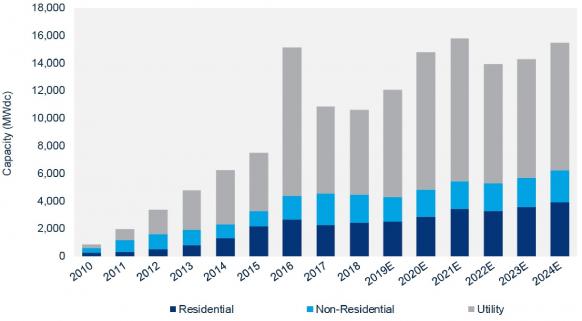EDF buys bifacial modules in giant Canadian Solar deal; Utah salt cavern to host 1 GW energy storage facility
Our pick of the latest solar news you need to know.

Related Articles
EDF backs bifacial modules in 1.8 GW Canadian Solar contract
Canadian Solar has signed its largest ever solar module agreement with EDF Renewables North America, to deliver 1.8 GW of bifacial and monofacial panels to projects in U.S., Canada and Mexico.
The agreement includes Canadian Solar's bifacial wafer BiHiKu (CS3W-PB) and HiKu (CS3W-P) modules.
The market for bifacial panels is set to take off this year as developers seek new ways to boost returns and gain a competitive edge.
Returns for U.S. bifacial plants could be 2.5% to 7% higher than monofacial designs, depending on the region, according to machine learning modelling performed by EDP Renewables (EDPR).
Leading tracker supplier NEXTracker is reportedly involved in over 750 MW of new bifacial solar projects in the U.S., including Invenergy's trailblazing 160 MW Southern Oak project in Mitchell County, Georgia. In April, Enel Green Power installed its first bifacial solar panels at the 220 MW Magdalena II solar plant in Tlaxcala, Mexico. Also due online in 2019, the Magdalena II plant will supply industrial customers via Mexico's wholesale market pool.
EDF is confident bifacial module technology can "support our robust pipeline of contracted projects over the next 5 years," Tristan Grimbert, President and CEO of EDF Renewables North America, said.
Canadian Solar has now signed over 3 GW of forward module supply contracts in North America for delivery through 2023, the company said.
U.S. solar activity is bouncing back after uncertainty over Section 201 tariffs prompted delays and dented construction in 2018.
U.S. utility-scale PV installations are forecast to hike to 7.8 GW in 2019, from 6.2 GW in 2018, according to the latest quarterly U.S. Solar Market Insight report, published by Wood Mackenzie and the Solar Energy Industry Association (SEIA) in March.
Strong demand in the coming years will see installations rise to 10 GW in 2020 and 10.4 GW in 2021, it said.
US PV installation forecast by segment
(Click image to enlarge)
Source: Wood Mackenzie Power and Renewables, March 2019.
Utah to host 1 GW storage facility using green hydrogen, compressed air
Mitsubishi Hitachi Power Systems (MHPS) and U.S. land developer Magnum Development are to build a 1 GW multi-technology energy storage facility in central Utah, the companies announced May 30.
The Advanced Clean Energy Storage (ACES) project will include renewable hydrogen, compressed air, large-scale flow battery and solid oxide fuel cell storage technology.
The partners aim to build 250 MW of capacity by 2025, rising to 1 GW at a later date, the Financial Times reported.
MHPS and Magnum are targeting growing storage demand in Western U.S. states, where rising solar and wind capacity has increased the need for storage capacity.
Electricity generation share from wind, solar in 2017
(Selected states)

The ACES project will be located within the only known “Gulf Coast” style domal-quality salt formation in the Western U.S. region. Owned by Magnum Development, the site is adjacent to the operational 1.9 GW Intermountain Power coal-fired power plant, which is expected to be converted to an 840 MW gas-fired plant by 2025.
The site already hosts five salt caverns already in operation for liquid fuel storage and the company is developing areas for compressed air and renewable hydrogen storage.
MHPS has developed gas turbine technology which uses a mixture of renewable hydrogen and natural gas to generate power. Going forward, the company aims to use "100% renewable hydrogen" as a fuel source for the turbines, it said in a statement.
By using a range of energy storage technologies, the ACES facility will be able to store power for durations from a few seconds to whole seasons, Paul Browning, President and CEO of MHPS Americas, said.
"In California and other states in the Western U.S, which will soon have retired all of their coal-fired power generation, we need the next step in decarbonization. Mixing natural gas and storage, and eventually using 100% renewable storage, is that next step," Browning said.
New Energy Update

